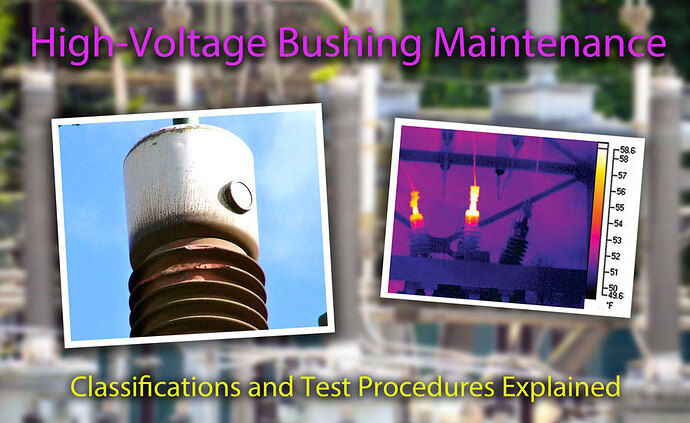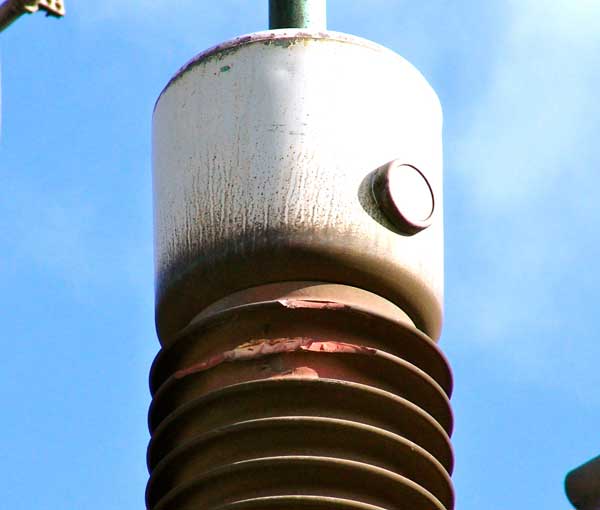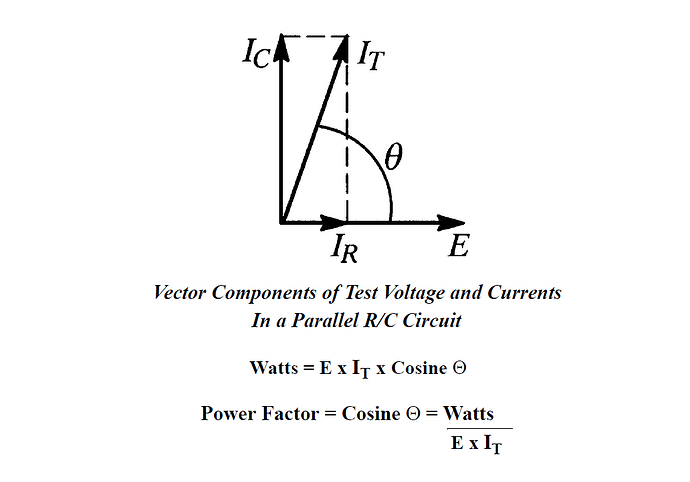The primary function of a bushing is to provide an insulated entrance for an energized conductor into a high-voltage apparatus tank or chamber. A bushing may also serve as a support for other energized parts of the apparatus.
Approximately 90% of all preventable bushing failures are caused by moisture entering through leaky gaskets, cracks, or seals. Moisture causes deterioration of the bushing insulation and can result in explosive failure, causing extensive transformer and other equipment damage, as well as hazards to personnel.
To prevent electrical catastrophes and optimize HV bushing service life, the following preventive maintenance and testing procedures should be performed at regular intervals.
Article Contents
- Visual Inspection of High-Voltage Bushings
- Infrared Inspection of High-Voltage Bushings
- Corona Inspection of High-Voltage Bushings
- Cleaning Methods for High-Voltage Bushings
- Power Factor Testing of High-Voltage Bushings
- HV Bushing Construction Classification and Type
- Maintenance Tips for High-Voltage Bushings
Visual Inspection of High-Voltage Bushings
Porcelain bushings should be regularly checked for cracks and/or contamination. If the bushing is damaged or heavily contaminated, leakage current will become excessive, sometimes appearing as carbon tracking, or “treeing,” on the bushing surface. Flashovers may occur if the bushings are not cleaned periodically.
Inspect the bushing carefully for oil leaks. Check the oil level in the bushing by viewing the liquid through the oil-sight glass or by observing the oil level gauge. If the level gauge is equipped with a pointer, document its position, as the level should vary slightly with temperature changes.
Porcelain bushing housing at polluted Ontario 230 kV substation shows impact from repeated pollution flashovers. Photo: INMR
If the liquid level never changes, even with a wide range of ambient temperatures, the gauge is most likely stuck and should be inspected at the next available outage. A defective gauge pointer along with a small oil leak can result in catastrophic failure of a bushing, causing damage to the apparatus and other switchyard equipment nearby.
Low oil levels in the bushing should be corrected by checking the mounting bolts for adequate torque and inspecting the gasket for proper compression. If torque and compression are found to be correct, the leak requires bushing replacement. It is very important that the correct type of gasket be installed, and the correct compression be applied.
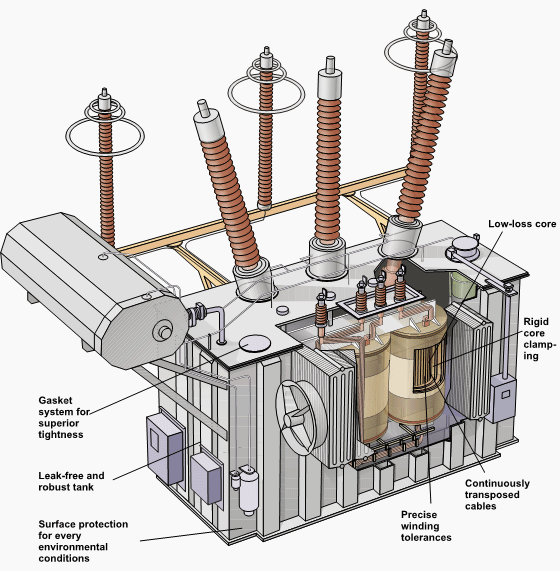
Gaskets with poor seals will leak water and air into the transformer. Photo: ABB.
Gaskets with poor seals are probably also leaking water and air into the transformer. In such cases, DGA samples should be obtained to check for high water and oxygen content inside the main tank. If oil levels are low and there is no evidence of external leaks, an internal leak could be present around the lower seal leading into the transformer tank.
Related: Insulating Liquids: Basic Properties, Types and Applications Explained
If possible, refill the bushing with the same type of oil and carefully monitor how much volume it takes to reach the proper level. Bushings that require more than 1 quart of oil should be marked and replaced at the next available outage. Defective bushings should be factory refurbished, as they cannot be repaired in the field.
Thermographic Inspection of High-Voltage Bushings
In addition to visual inspections, high-voltage bushings should be examined with an infrared camera. If any of the bushings are abnormally hot when compared to a unit under similar loading, there is probably a loose connection.
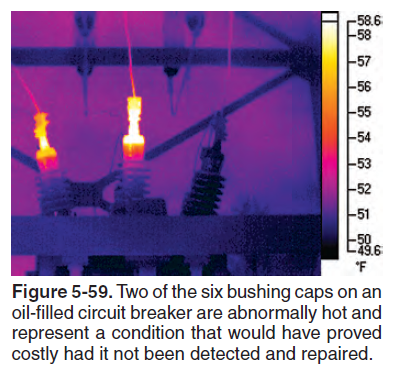
Infrared inspections can reveal connection issues on high-voltage bushings. Photo: Fluke Corporation.
It’s not uncommon to find problems with the connection at the top of the bushing; however, a defective connection inside the transformer tank will also show a higher temperature at the top of the bushing. Bad connections inside a transformer will usually exhibit hot metal gases such as ethane and ethylene in DGA samples.
Related: Infrared Thermography for Electrical Distribution Systems
Corona Inspection of High-Voltage Bushings
Corona (air ionization) may be visible at the tops of bushings at twilight or night, especially during periods of rain, mist, fog, or high humidity. Corona is considered normal near the top of the bushing; however, as contamination builds, corona will creep lower and lower.
A corona scope may be used to view and photograph low levels of corona indoors under normal illumination and outdoors at twilight or night. High levels of corona may be viewed outdoors in the daytime if a dark background is available, such as trees, canyon walls, buildings, etc. This inspection will be required more often in atmospheres where salts and dust deposits appear on the bushings.
If corona seems to be lower than the top of the bushing, visually inspect, electrically test, and clean the bushing as quickly as possible. The corona scope design is primarily for indoor and night use; it can’t be used with a blue or cloudy sky background.
Cleaning Methods for High-voltage Bushings
If bushings are not periodically cleaned, a phase-to-ground fault can occur when corona nears the grounded transformer tank, potentially destroying the bushing and causing an extended outage.
Consult the manufacturer’s literature for detailed instructions on cleaning and repairing specific bushing surfaces. Different solvents, wiping materials, and cleaning methods may be required for different bushings.
Related: Cleaning Methods for Electrical Preventive Maintenance
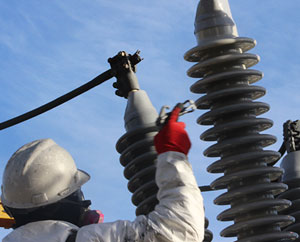
Cleaning high voltage insulators are important to maintain the insulator operating and insulator service time. Photo: Composite Insulator
Hairline cracks in the surface of the porcelain should be sealed because accumulated dirt and moisture can work their way into the crack, potentially resulting in a flashover. Epoxy can be used to repair larger chips, but different repair techniques may be required for small cracks and chips.
If a bushing insulator has a large chip that reduces the flashover distance, or has a large crack totally through the insulator, the bushing should be immediately replaced. Some manufacturers offer repair services for damaged bushings that cannot be repaired in the field. Contact the manufacturer for your particular bushings if you have repair questions.
In high humidity and wet areas, a high-quality silicone wax applied to the porcelain will cause water to form beads, rather than a continuous sheet, reducing the risk of flashover.
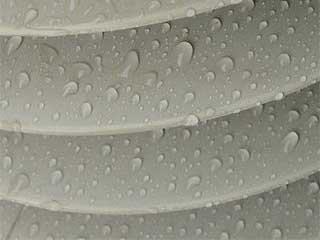
Beads of rainwater on the surface of a high voltage insulator. Photo: electropod (Flickr)
Cleaning bushings may involve simply applying silicone wax and wiping with a soft cloth. Contaminants that are more stubborn may require solvents, steel wool, and brushes. High-pressure water may be required to remove salt and other water-soluble deposits. Limestone powder blasting with dry air will safely remove metallic oxides, chemicals, salt cake, and almost any hard contaminant.
Other materials known to safely remove hard contaminants from high-voltage bushings include potter’s clay, walnut or pecan shells, or crushed coconut shells. Carbon dioxide (CO2) pellet blasting is a more expensive alternative that virtually eliminates cleanup through evaporation.
Ground-up corncob blasting can be used to remove soft pollutants, such as old coatings of built-up grease. A competent, experienced contractor should be employed, and a thorough, written job hazard analysis (JHA) should be performed when any of these treatments are used.
Power Factor Testing of High-Voltage Bushings
Insulation power-factor tests are used to measure dielectric losses, which relate to the wetness, dryness, or deterioration of high-voltage insulation. Leakage current comprises two components: resistive current and capacitive current. In practice, no insulation is perfect, but has a certain amount of loss, and the total current leads the voltage by a phase angle less than 90°.
Testing power factor is a means of measuring the integrity of electrical insulation. Photo: Doble Engineering.
High-voltage bushings are usually equipped with a tap for test measurements. The bushing nameplate should list the tap capacitance and power factor of the C2 insulation, as measured from the tap to the grounded flange.
Perform power-factor or dissipation-factor tests on each bushing equipped with a power-factor/capacitance tap. In the absence of a power-factor/capacitance tap, hot-collar tests should be used. The methods of power factor testing in regards to procedure are beyond the scope of this article; consult manufacturer literature for detailed test methods.
Related: 3 Basic Modes of Power Factor Testing Explained
The various types of power factor tests applicable to high-voltage bushings may include:
-
Overall Test (from Center Conductor to Flange).
-
Ungrounded-Specimen Test, or UST (Center Conductor to Tap, C1).
-
Inverted UST Test (Tap to Center Conductor, C1).
-
Cold Guard (Center Conductor to Flange).
-
Tap Insulation Test (Tap to Flange, C2).
-
Alternate C2 Test (C1 and C2 in Parallel).
-
Collar Tests (Externally Applied Collar to Center Conductor).
Investigate bushing power-factor and capacitance values that vary from nameplate values by more than 10%. Hot-collar tests are evaluated on a milliampere/milliwatt loss basis, and the results should be compared to values of similar bushings.
Bushings should be cleaned before power factor testing. Contamination on the insulating surface will cause the results to be inaccurate. Testing may also be done before and after cleaning to observe the effectiveness. Keep accurate records of results so that replacements can be ordered in advance, before removing HV bushings from service.
Bushing Construction Classification and Type
High-voltage bushings may be classified generally by design as follows:
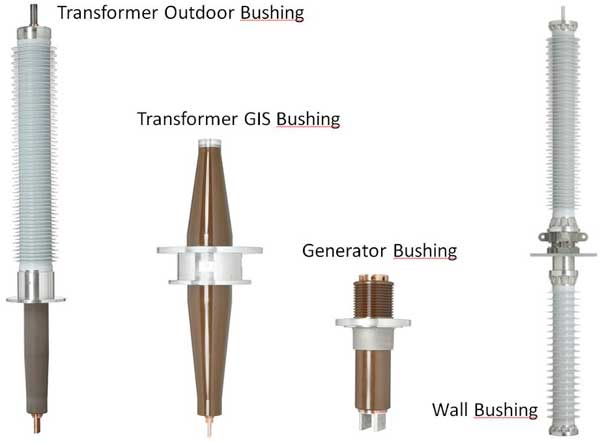
High voltage bushings are available in various classifications and styles.
Condenser Type
Condenser bushings provide greater dielectric strength and uniform voltage gradient. These bushings form a capacitor between the live conductor and the equipment body which is at ground potential.
-
Oil-Impregnated Paper Insulation, with Interspersed Conducting (Condenser) Layers or Oil-Impregnated Paper Insulation, Continuously Wound with Interleaved Lined Paper Layers.
-
Resin-Bonded Paper Insulation, with Interspersed Conducting (Condenser) Layers.
Non-condenser type
Used in both low voltage and high-voltage applications. In low voltage applications, the ceramic casing alone provides adequate insulation to the conductor.
- Solid Core, or Alternate Layers of Solid and Liquid Insulation.
- Solid Mass of Homogeneous Insulating Material (e.g., Solid Porcelain).
- Gas Filled.
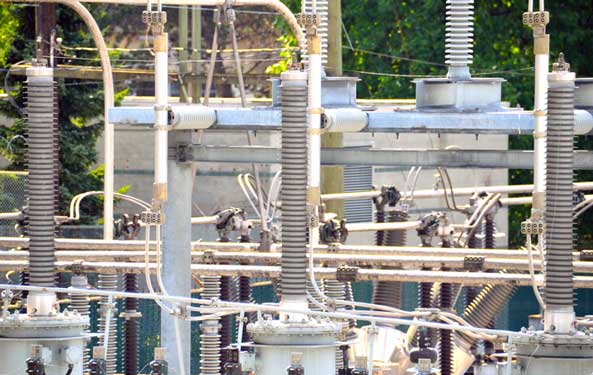
Bushings in a high-voltage switchyard. Photo: Wikimedia
Bushing Maintenance Tips
New bushings should be tested outside of their shipping crate as wood does not insulate as well as porcelain and will cause power factor readings to be inaccurate. Test results should be retained as a baseline record to compare with tests in the future.
Some bushings have a nitrogen blanket on top of the oil, which pressurizes as the oil expands. This pressurized hot oil may suddenly gush from the fill plug if it is removed while at an elevated temperature, causing burn hazards.
Oil fill plugs should never be opened if the bushing is at an elevated temperature. Always consult the manufacturer’s instruction manual, which will give the temperature range at which the bushing may be safely opened.
